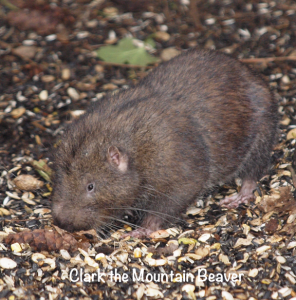Facts About Mountain Beavers…
 The Mountain Beaver or Aplodontia Rufa, as they are scientifically known, is the most primitive rodent alive today. Their name is a misnomer as they are not actually a beaver and they prefer lower elevations.
The Mountain Beaver or Aplodontia Rufa, as they are scientifically known, is the most primitive rodent alive today. Their name is a misnomer as they are not actually a beaver and they prefer lower elevations.
They are the only member of their biological family and have survived practically unchanged for 40,000 years!
Being so primitive, they have insufficient kidneys and must drink one third of their body weight in water every day.
Mountain beavers are 10 to 18 inches long and weigh 2 to 3 pounds. They have fine short reddish brown hair, short thin ears, thick necks, short legs, long toes, sharp nails and a stub for a tail.
The life span of a mountain beaver is approximately 5 to 10 years.
They live in moist forests and can only be found in the PNW from Southern British Columbia down through Western Washington and Oregon and into Northern California.
Mountain beavers are herbivores and eat a wide variety of plants. They find the majority of their food and water within 150 feet from their burrows.
Mountain beavers are powerful diggers. Their burrowing systems are complex and may contain 10 or more entrances with special rooms for nesting, feeding, storing food and for storing their scat or poop.
Mountain beavers have various calls including whistles, squeals and booming sounds but the most frequent call is a chattering or grinding noise made with their teeth.
Mountain beavers must keep chewing throughout their entire life in order to keep their teeth from growing too long. They groom their teeth on “beaver baseballs” —chunks of stone or clay— which they encounter in digging their burrows.
Animals that prey upon mountain beavers include coyotes, large owls, bobcats and fishers.
Mountain beaver populations are believed to be healthy, but like many critters, loss of habitat due to continued development is a reasonable threat. Mountain beavers serve an important function in nature due to the amount of soil they move and the number of vacant burrows they leave behind for other critters to inhabit.
Since mountain beavers spend the majority of their lives underground they are seldom seen and most people don’t even know they exist!
———————
